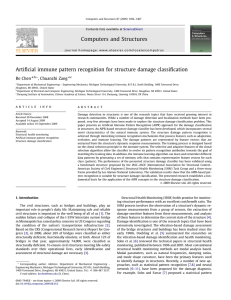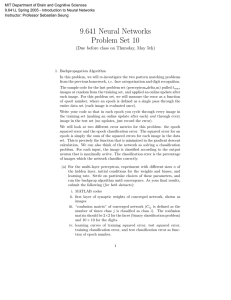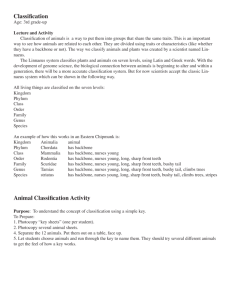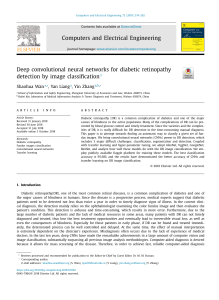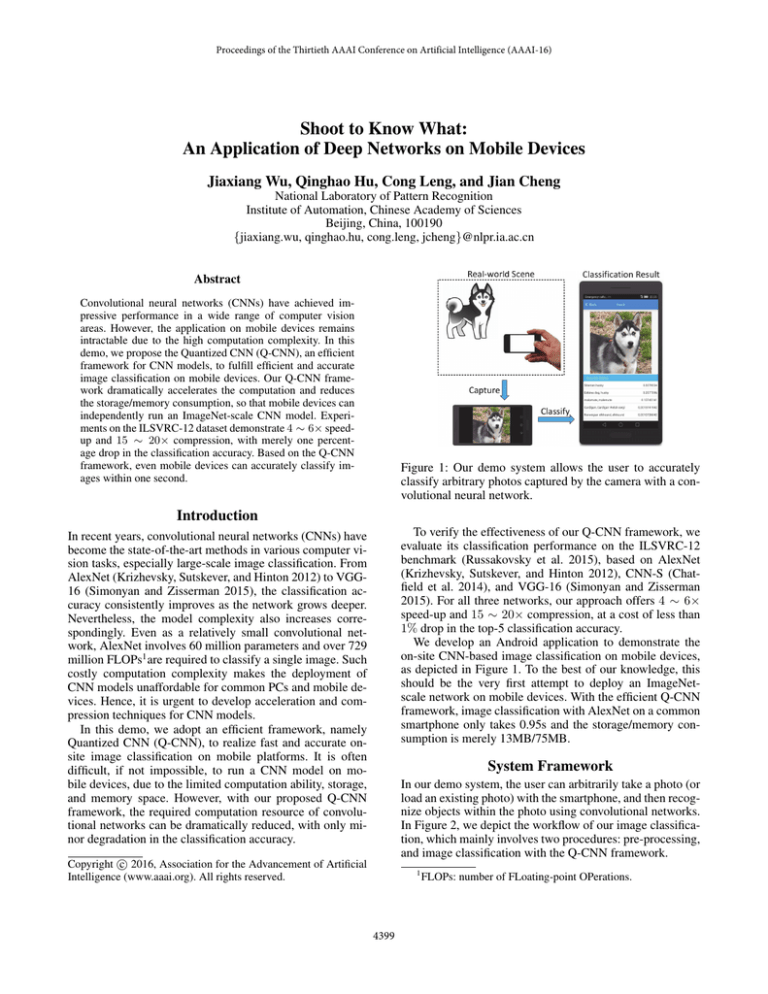
Proceedings of the Thirtieth AAAI Conference on Artificial Intelligence (AAAI-16)
Shoot to Know What:
An Application of Deep Networks on Mobile Devices
Jiaxiang Wu, Qinghao Hu, Cong Leng, and Jian Cheng
National Laboratory of Pattern Recognition
Institute of Automation, Chinese Academy of Sciences
Beijing, China, 100190
{jiaxiang.wu, qinghao.hu, cong.leng, jcheng}@nlpr.ia.ac.cn
Abstract
Convolutional neural networks (CNNs) have achieved impressive performance in a wide range of computer vision
areas. However, the application on mobile devices remains
intractable due to the high computation complexity. In this
demo, we propose the Quantized CNN (Q-CNN), an efficient
framework for CNN models, to fulfill efficient and accurate
image classification on mobile devices. Our Q-CNN framework dramatically accelerates the computation and reduces
the storage/memory consumption, so that mobile devices can
independently run an ImageNet-scale CNN model. Experiments on the ILSVRC-12 dataset demonstrate 4 ∼ 6× speedup and 15 ∼ 20× compression, with merely one percentage drop in the classification accuracy. Based on the Q-CNN
framework, even mobile devices can accurately classify images within one second.
Figure 1: Our demo system allows the user to accurately
classify arbitrary photos captured by the camera with a convolutional neural network.
Introduction
To verify the effectiveness of our Q-CNN framework, we
evaluate its classification performance on the ILSVRC-12
benchmark (Russakovsky et al. 2015), based on AlexNet
(Krizhevsky, Sutskever, and Hinton 2012), CNN-S (Chatfield et al. 2014), and VGG-16 (Simonyan and Zisserman
2015). For all three networks, our approach offers 4 ∼ 6×
speed-up and 15 ∼ 20× compression, at a cost of less than
1% drop in the top-5 classification accuracy.
We develop an Android application to demonstrate the
on-site CNN-based image classification on mobile devices,
as depicted in Figure 1. To the best of our knowledge, this
should be the very first attempt to deploy an ImageNetscale network on mobile devices. With the efficient Q-CNN
framework, image classification with AlexNet on a common
smartphone only takes 0.95s and the storage/memory consumption is merely 13MB/75MB.
In recent years, convolutional neural networks (CNNs) have
become the state-of-the-art methods in various computer vision tasks, especially large-scale image classification. From
AlexNet (Krizhevsky, Sutskever, and Hinton 2012) to VGG16 (Simonyan and Zisserman 2015), the classification accuracy consistently improves as the network grows deeper.
Nevertheless, the model complexity also increases correspondingly. Even as a relatively small convolutional network, AlexNet involves 60 million parameters and over 729
million FLOPs1 are required to classify a single image. Such
costly computation complexity makes the deployment of
CNN models unaffordable for common PCs and mobile devices. Hence, it is urgent to develop acceleration and compression techniques for CNN models.
In this demo, we adopt an efficient framework, namely
Quantized CNN (Q-CNN), to realize fast and accurate onsite image classification on mobile platforms. It is often
difficult, if not impossible, to run a CNN model on mobile devices, due to the limited computation ability, storage,
and memory space. However, with our proposed Q-CNN
framework, the required computation resource of convolutional networks can be dramatically reduced, with only minor degradation in the classification accuracy.
System Framework
In our demo system, the user can arbitrarily take a photo (or
load an existing photo) with the smartphone, and then recognize objects within the photo using convolutional networks.
In Figure 2, we depict the workflow of our image classification, which mainly involves two procedures: pre-processing,
and image classification with the Q-CNN framework.
c 2016, Association for the Advancement of Artificial
Copyright Intelligence (www.aaai.org). All rights reserved.
1
4399
FLOPs: number of FLoating-point OPerations.
Figure 2: The workflow of the image classification process on mobile devices, based on our Q-CNN framework.
Pre-processing
Table 1: The speed-up/compression rates and the increase in
the top-5 classification error rates of our Q-CNN framework.
A few pre-processing operations are required before feeding
the captured photo into the convolutional network for classification. Firstly, we resize the image to 256 × 256, or resize
the shorter side to 256, depending on the choice of CNN
models. Then we crop out the central patch from the resized
image and remove the mean value for each pixel.
Model
(Top-5 Err.)
AlexNet
(19.74%)
CNN-S
(15.82%)
VGG-16
(10.06%)
Image Classification with Q-CNN
The Q-CNN framework we adopted here takes a CNN model
(trained on ImageNet) as the reference model, and then generates a quantized version of it. The major advantage is
that Q-CNN can speed-up the computation and reduce the
storage/memory consumption dramatically, with only minor performance degradation. Both the filter kernels (convolutional layers) and weighting matrices (fully-connected
layers) are quantized with codebooks. The quantization is
learned via minimizing the estimation error of each layer’s
response. After quantization, only codebooks and quantization indexes are stored, which is much more efficient in storage/memory than storing network parameters.
During the test-phase, instead of the standard convolutional and matrix multiplication operations, we approximately compute each element in the layer response as the
addition of multiple inner products, which can be directly
fetched from a pre-computed look-up table. Therefore, the
computation can be significantly accelerated.
Speed-up
Compression
Top-5 Err. ↑
4.05×
4.15×
5.69×
5.78×
4.05×
4.06×
15.40×
18.76×
16.32×
20.16×
16.55×
20.34×
0.84%
0.97%
0.81%
0.85%
0.58%
0.65%
Table 2: Comparison on the running time, storage, memory
consumption, and classification error rates of CNN models.
Model
AlexNet
CNN-S
CNN
Q-CNN
CNN
Q-CNN
Time
Storage
Memory
Top-5 Err.
2.93s
0.95s
10.58s
2.61s
232.56MB
12.60MB
392.57MB
20.13MB
264.74MB
74.65MB
468.90MB
129.49MB
19.74%
20.70%
15.82%
16.68%
computation resource, while the loss in the classification accuracy is no more than 1%.
Acknowledgement
This work was supported in part by 863 Program (Grant No.
2014AA015100), and National Natural Science Foundation
of China (Grant No. 61332016, 61170127).
References
Chatfield, K.; Simonyan, K.; Vedaldi, A.; and Zisserman, A.
2014. Return of the devil in the details: Delving deep into convolutional nets. In British Machine Vision Conference (BMVC).
Krizhevsky, A.; Sutskever, I.; and Hinton, G. E. 2012. Imagenet
classification with deep convolutional neural networks. In Advances in Neural Information Processing Systems (NIPS), 1106–
1114.
Russakovsky, O.; Deng, J.; Su, H.; Krause, J.; Satheesh, S.; Ma,
S.; Huang, Z.; Karpathy, A.; Khosla, A.; Bernstein, M.; Berg,
A. C.; and Fei-Fei, L. 2015. Imagenet large scale visual recognition challenge. International Journal of Computer Vision (IJCV)
1–42.
Simonyan, K., and Zisserman, A. 2015. Very deep convolutional
networks for large-scale image recognition. In International Conference on Learning Representations (ICLR).
Experiments
We evaluate our Q-CNN framework’s performance on the
ILSVRC-12 benchmark for image classification. We report
the top-5 classification error rate of 50k validation images,
using single-view testing (central patch only). Three CNN
models are used (AlexNet, CNN-S, and VGG-16), and we
report the performance on these networks in Table 1.
We have also developed an Android application to integrate our Q-CNN framework into mobile devices, which
should be the first attempt to run an ImageNet-scale CNN
model on mobile platforms. In Table 2, we compare the performance of the original and quantized CNN models on a
R
Huawei
Mate 7 smartphone, equipped with an 1.8GHz
Kirin 925 CPU. The Q-CNN framework requires much less
4400


